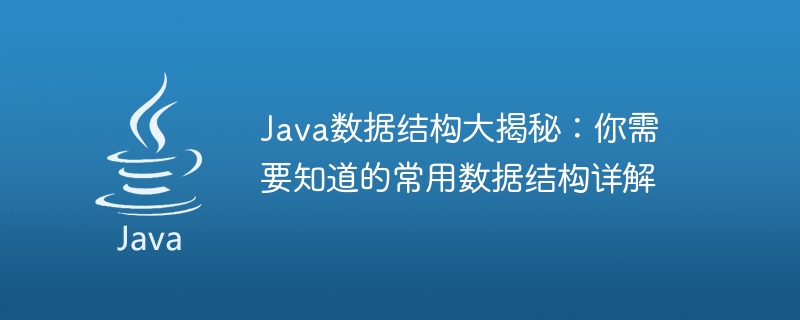

Java Data Structure Revealed: Detailed explanation of common data structures you need to know
Introduction:
When developing any software system, the data structure is Indispensable part. It is the way in which data is organized and stored in memory, which determines the efficiency of operations such as data access, insertion, deletion and modification. In Java programming, there are many commonly used data structures that can help us better organize and manage data. This article will explain commonly used data structures in detail and provide specific code examples.
1. Array:
An array is the simplest data structure, which is a set of continuously stored elements of the same type. In Java, the length of an array is fixed and cannot be changed once created. Elements in the array can be accessed through indexing, which starts from 0.
Sample code:
int[] array = new int[5]; // 创建一个长度为5的整型数组 array[0] = 1; array[1] = 2; array[2] = 3; array[3] = 4; array[4] = 5;
2. Linked List:
The linked list is composed of a set of nodes, each node contains a data element and a pointer to the next node citation. In Java, linked lists can be automatically expanded and elements can be added and deleted dynamically.
Sample code:
LinkedList<String> linkedList = new LinkedList<String>(); // 创建一个字符串链表
linkedList.add("a");
linkedList.add("b");
linkedList.add("c");
linkedList.remove("b");3. Stack:
The stack is a data structure that follows the first-in, last-out (LIFO) principle. In Java, the stack can be implemented using the Stack class, which provides methods such as push() and pop() for push and pop operations.
Sample code:
Stack<Integer> stack = new Stack<Integer>(); // 创建一个整型栈 stack.push(1); stack.push(2); stack.push(3); int top = stack.pop(); // 出栈操作,top的值为3
4. Queue:
Queue is a data structure that follows the first-in-first-out (FIFO) principle. In Java, queues can be implemented using the Queue interface. Common implementation classes include LinkedList and PriorityQueue.
Sample code:
Queue<String> queue = new LinkedList<String>(); // 创建一个字符串队列
queue.add("a");
queue.add("b");
queue.add("c");
String front = queue.remove(); // 出队操作,front的值为"a"5. Heap:
Heap is a special tree structure with the following characteristics: the value of the parent node is greater than or equal to The value of the child node (max-heap), or the value of the parent node is less than or equal to the value of the child node (min-heap). In Java, you can use PriorityQueue to implement a heap.
Sample code:
PriorityQueue<Integer> maxHeap = new PriorityQueue<Integer>(Collections.reverseOrder()); // 创建一个最大堆 maxHeap.add(4); maxHeap.add(2); maxHeap.add(7); int max = maxHeap.poll(); // 从堆中取出最大值,max的值为7
Conclusion:
The above only introduces several common data structures. In fact, Java also provides more data structures, such as trees, Graphs, hash tables, etc. Choosing appropriate data structures can improve the efficiency and performance of your program. When writing Java programs, it is necessary to understand commonly used data structures and their characteristics and usage in order to choose the most appropriate data structure to solve specific problems.
Reference materials:
1. "Data Structure and Algorithm Analysis - Java Language Description" by Mark Allen Weiss
2. https://docs.oracle.com/javase/8 /docs/api/java/util/package-summary.html
(Note: The sample code used in this article is only a demonstration. In the real environment, corresponding exception handling and boundary judgment need to be carried out according to the actual situation.)
The above is the detailed content of Revealing the secrets of commonly used data structures in Java: in-depth explanation of essential knowledge. For more information, please follow other related articles on the PHP Chinese website!




